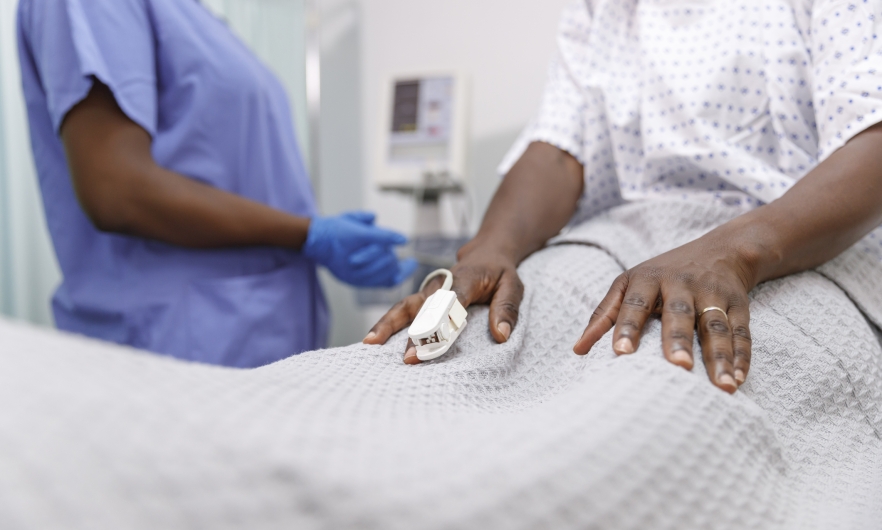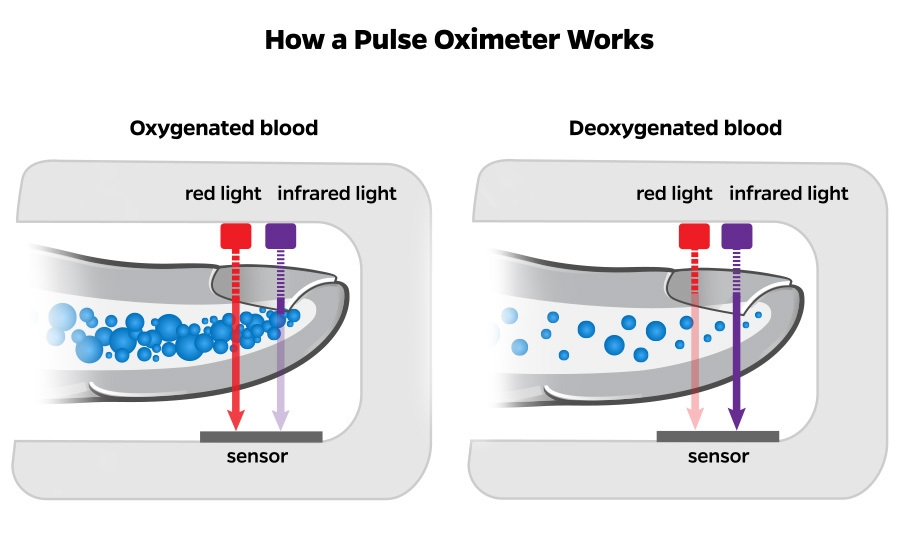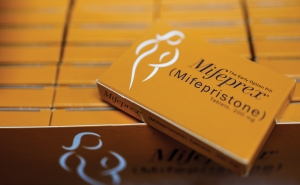The Problem with Pulse Oximeters: A Long History of Racial Bias
Racial bias in pulse oximetry has been documented for decades—why hasn’t more been done to fix it?

Listen to the special series of the Public Health On Call podcast:
Part 1: A Problem Hiding in Plain SightPart 2: What Went Wrong?Part 3: Fixing Pulse Oximeters
Hear directly from patients, clinicians, historians, regulators, manufacturers, engineers, and more.
Pulse oximeters—small sensors clipped to a finger or toe that use light to measure oxygen saturation in the blood—are ubiquitous in health care. In 2022, the global pulse oximeter market was valued at $2.4 billion and is expected to reach $5.4 billion by 2033. Hundreds of medical-grade devices are on the market, and countless consumer-grade models are available.
Pulse oximeter readings help guide essential care decisions, like whether a patient in surgery or an intensive care unit needs lifesaving supplemental oxygen.
But for decades, studies have shown that the devices overestimate oxygen levels in patients with darker skin tones. A 1990 paper found that pulse oximeters overestimated oxygen saturation to a greater degree in Black patients than in white patients. Papers published in 2005 and in 2007 also found that pulse oximeters overestimated oxygen levels in individuals with darker skin tones.
Until recently, these findings were largely ignored and even denied by both manufacturers and regulators, and not well understood by clinicians—allowing for the widespread proliferation of biased devices.
In turn, regulations have not required that the devices work well across the full range of skin tones; manufacturers have continued making devices designed to work best on lighter skin; and clinicians and medical students have largely been unaware of pulse oximeters’ shortcomings.
COVID-19 was a turning point. The pandemic brought a broader reckoning with racism and disparities in health care, and new data on racial bias in pulse oximetry drew fresh attention and scrutiny to the issue—from physicians, biomedical engineers, advocates, and crucially, the Food and Drug Administration.
In response to the latest research, and amid growing calls for change, the FDA pledged to prioritize the issue and this year expects to publish new recommendations on how to test and approve pulse oximeters.
Still, the path forward remains unclear. Why has it taken so long to address racial bias in pulse oximetry?
Biased from the Beginning
The pulse oximeter that first took off in the U.S. was—like most medical devices and light-sensing technologies—originally designed for and tested on lighter skin tones. It was first conceived in the 1970s in Japan, where the population has relatively little variation in skin tone compared to the United States.
Nevertheless, a pulse oximeter based on that design became wildly popular in the U.S. The N-100 pulse oximeter, from the company Nellcor, was launched in 1981 and sold like gangbusters, becoming a go-to method for measuring oxygen in clinical settings and setting a precedent for generations of devices. By the mid-1980s, pulse oximeters were “in nearly every operating room, recovery room, and intensive care unit in North America,” wrote one anesthesiology professor in a tribute to the Japanese pulse oximeter pioneer, Takuo Aoyagi.
Today’s pulse oximeters come as reusable plastic clamps or foam Velcro straps that attach to a finger or toe, or can be embedded in flexible adhesive tape that wraps around a fingertip. These devices allow for continuous, but less staff-intensive, monitoring of patients’ oxygen saturation and earlier alerts of respiratory complications.
An oxygen saturation of 100% indicates that the blood is carrying as much oxygen as it can. Levels of 95% or above are considered very good, while those in or below the low 90s reflect an underlying problem, such as pneumonia, heart failure, or other lung diseases.
Pulse oximeters use light to make these measurements. The devices emit visible red light, which travels through the patient’s finger or toe, and measure how much light is absorbed by the finger: The higher the level of oxygen in the blood, the more light gets absorbed. If the probe detects that more light is escaping, that means oxygen saturation has fallen—a sign of potential respiratory distress.

A pulse oximeter attaches to a finger or toe and shines red and infrared light through to a sensor, which calculates the patient's oxygen saturation (SpO2) based on how much light is absorbed. Oxygenated blood absorbs more infrared light than red light, and deoxygenated blood absorbs more red light than infrared light.
But the devices don’t work equally well for everyone. “The challenge for melanated individuals is [that] the presence of melanocytes”—skin cells that produce the skin-darkening pigment, melanin—“disrupt the transmission of that infrared light through the skin,” explains Joseph Wright, MD, MPH, a pediatric emergency physician, and chief health equity officer of the American Academy of Pediatrics.
As a result, for darker-skinned patients, oxygen saturation readings can read as normal when they are, in fact, dangerously low.
The COVID Turning Point
During the pandemic, care teams in overwhelmed hospitals relied on pulse oximeters as they have done for decades, using their readings to make decisions about whether patients could go home or needed to stay at the hospital.
For Tom Valley, MD, MSc, a pulmonary critical care physician at the University of Michigan, the pandemic presented a first opportunity to observe the problems with pulse oximeters, which he had not been taught about in medical school. Black people were disproportionately being hospitalized and dying from COVID—and his patient demographic flipped from mostly white to primarily Black and Hispanic patients.
In addition to pulse oximeters, Valley’s ICU used arterial blood gas, or ABG, readings to measure oxygen levels for all COVID patients. The method is more invasive, using a catheter inserted into an artery in the patient’s wrist, but it allows care teams to draw blood and to measure oxygen levels directly, rather than relying on an indirect measurement such as light absorption through the pulse oximeter. But the method had fallen out of favor—which is partially why so few clinicians had seen the problems with pulse oximeters.
“We've been kind of moving away from it, mainly because people were like, do we really need these devices, the pulse oximeter has worked so well,” Valley says.
Between the two ways of measuring oxygen—in an ICU full of darker-skinned patients—a major discrepancy emerged. In a December 2020 research letter published in the New England Journal of Medicine, Valley and his co-authors found that Black COVID patients were three times as likely to have a significant discrepancy between pulse oximeter and ABG readings. Twelve percent of the time, when Black patients had a pulse oximeter reading in the “safe range”—92% to 96%—their actual saturation on an ABG test was below 88%. In white patients, this discrepancy occurred 4% of the time. Further research bolstered their findings, showing that inaccurate pulse oximeters were linked to delayed or lack of treatment for Black patients with severe COVID.
“It was absolutely shocking,” says Valley, even more so when he realized that these shortcomings were documented decades earlier but weren’t taught in medical school or addressed by regulators and manufacturers. “I certainly felt guilt. I thought of the patients that I've potentially caused harm to, because I didn't consider that these devices might not work as well for them compared to others.”
Amid a national reckoning with racism, the results made headlines and opened up a conversation about the need to improve pulse oximeters—and how flawed devices had proliferated in the first place.
Baked-in Bias and Medical Racism
Light-skinned individuals have been the default baseline for assessing medical devices, while insights into other skin tones were considered “nice to have,” says Theodore “Jack” Iwashyna, MD, PhD, a Johns Hopkins ICU physician and Bloomberg Distinguished Professor at the Johns Hopkins School of Medicine and in Health Policy and Management at the Bloomberg School.
“The reality is, function in white patients was considered the norm, and function in Black patients was considered a clinical nuance that certain experts were supposed to know about” in specialties like anesthesiology and pulmonology, he says.
The long-unexamined racial bias in pulse oximetry, and its omission from medical school teachings, is a “perfect example—a contemporary example—of how systemic racism in health care works and how we overlook things,” says Noha Aboelata, a family physician and CEO of Roots Community Health Center in Oakland, California, which has filed a lawsuit against manufacturers and distributors of pulse oximeters.
Structural racism in American medicine has had a lasting legacy not just on which researchers are funded—in 2020, less than 3% of NIH’s principal investigators were Black—but on what topics were considered relevant and useful.
These issues are now beginning to be acknowledged at the highest levels of medicine. In 2021, Francis Collins, then-director of the NIH, the largest single public funder of biomedical and behavioral research in the world, apologized for racism in research funding, saying that “the NIH is committed to supporting equity and inclusion and identifying and dismantling any policies and practices that may harm our workforce and science.”
Physician advocates, patients, and medical students are also playing a key role in changing these norms. Aboelata’s lawsuit, for example, helped spur a coalition of state attorneys general to write a letter pushing the FDA to act faster to address the inequity in pulse oximetry.
Regulatory Blind Spots
The FDA—which sets standards for pulse oximeters and other medical devices—is a part of this problematic but slowly shifting medical zeitgeist. Until very recently, the agency’s standards for pulse oximeters essentially ignored how skin tone can affect a pulse ox reading.
FDA clearance is crucial to bringing clinical devices to market and rolling them out in hospitals. But in the 1980s, when pulse oximeters became the standard of care, the FDA’s medical device regulations were in their infancy.
Today, the FDA clears pulse oximeters under what’s called the 510(k) review process, which requires manufacturers to prove that their device is “substantially similar to another marketed device” cleared under similar rules. This process has many advantages for bringing devices quickly to market. It also means that if the initial device is flawed, then other devices can be brought to market with the same flaws.
According to the 510(k) database, there are now hundreds of pulse oximeter clearances based on old designs that were greenlit decades ago, with little regard for health equity or racial bias.
For pulse oximeters and other medical devices, the FDA also sets testing standards. The agency’s latest guidance, set in 2013, recommends that manufacturers include at least two “darkly pigmented subjects”—or 15% of the study participants, whichever is larger—in their premarket studies. But this is not a requirement, and methods for measuring skin tone have historically been subjective and often inaccurate.
Moreover, the agency has long relied on manufacturer-provided data to assess pulse oximeters—and that data has been based on studies of healthy volunteers, rather than in real-world clinical settings that researchers like Valley and Iwashyna regard as essential.
There is now movement to change these standards. As with physicians and the general public, the pandemic was a turning point for the FDA. Addressing racial bias in pulse oximetry has been a priority for the agency “since 2020, when it became apparent that the issue was indeed a significant public health concern,” says Malvina Eydelman, director of the FDA’s Office of Health Technology.
In November 2022, an FDA panel agreed that the available clinical evidence from real-world studies showed that pulse oximeters didn’t work as well in people with darker skin pigmentation. Even more recently, in February of this year, FDA advisers from the Anesthesiology and Respiratory Therapy Devices Panel of the Medical Devices Advisory Committee proposed new guidance for pulse ox clinical testing.
They recommended increasing the number of patients in clinical studies to a minimum of 24—including subjects from across the Monk Skin Tone scale—a measure of skin color designed to be inclusive of the entire range of skin pigmentation in the U.S. and launched in 2022.
Still, some researchers wonder if the FDA’s changes go far enough. Among other questions, it’s still unclear how new standards will affect already-approved devices and whether the focus of testing will still be on healthy patients.
Looking Ahead
Getting regulatory standards right is essential to achieving equity in pulse oximeters—but it’s not the only factor.
“It's really difficult to fix this device without dealing with the institutions around it,” says Amy Moran-Thomas, PhD, MA, an MIT medical anthropologist who has reported extensively on pulse oximeter bias. Those institutions include regulators that didn't set reasonable standards; as well as a medical community that ignored alarming reports in scientific literature; companies that rushed products to market before asking essential questions; and medical schools that left the issue out of their curricula.
Eliminating pulse oximetry bias requires decisive action to address all of these factors—and crucially, broad acknowledgment of the existence of racial bias in medical devices to ensure a similar problem doesn’t happen again.
For Joseph Wright, the American Academy of Pediatrics’ health equity officer, that means encoding a new norm into the conversation about medical devices.
“We are moving into an environment where our approaches to clinical care have to be race-conscious,” he says. “In other words, very cognizant of the fact that bias could be part of the root cause of particular decisions around care delivery, or in this case, particular decisions around the use or the approval of a certain technology.”
*This article is based on a three-part special series the Public Health On Call podcast that looks into how biased pulse oximeters came to market in the first place, why it’s taken so long to address the issue, and the questions that still remain about how to improve the devices. Listen to the full series here.
Annalies Winny is a writer and producer at the Johns Hopkins Bloomberg School of Public Health, and co-producer of this special series on pulse oximeters.
Nicole Jurmo is co-producer of this special series on pulse oximeters, the associate director for public relations and communications for the Johns Hopkins Center for Communication Programs, and a current MPH student. She recently completed a practicum with the Public Health On Call podcast.
RELATED:
More from the Bloomberg School
- See latest headlines
- Learn more about our departments:





